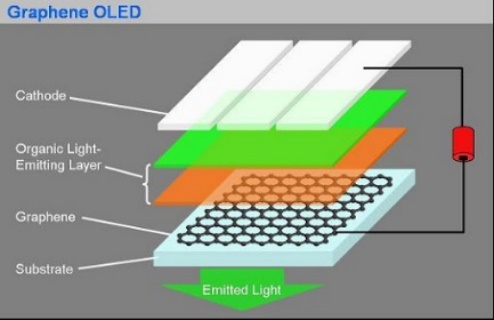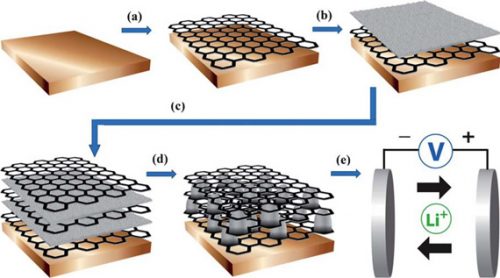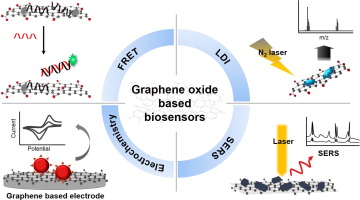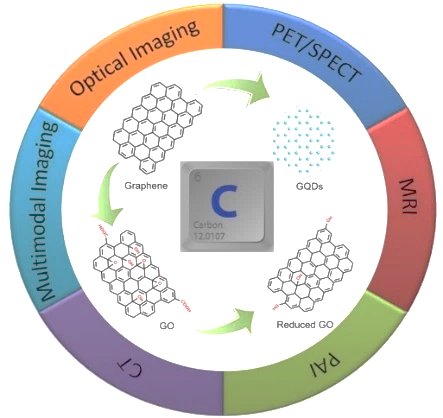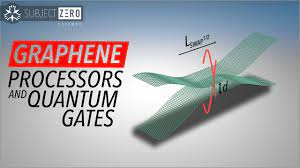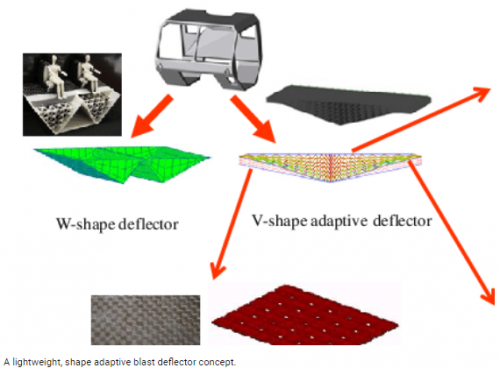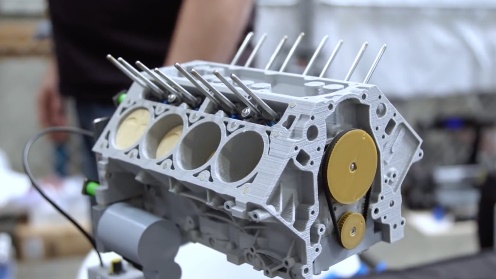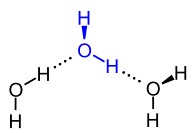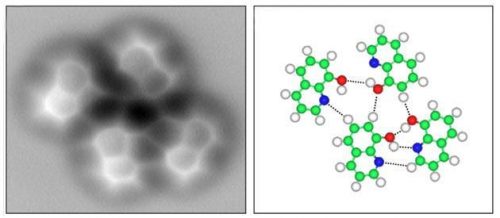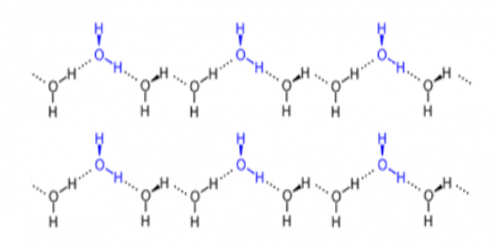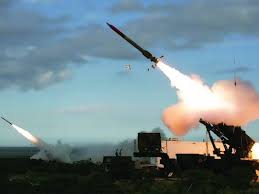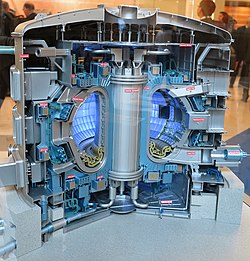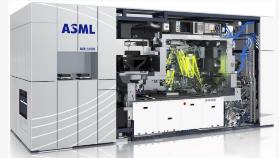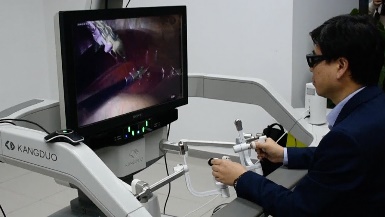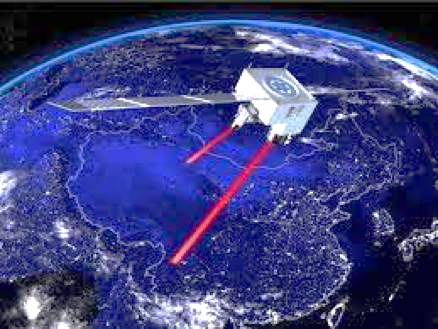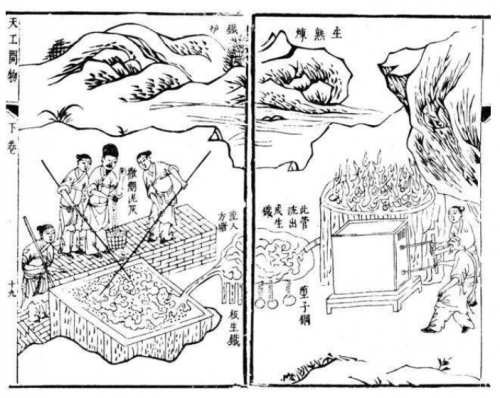a. Water as a source of energy by developing a new and economically viable method of O-H bond fission
(i) Hydrogen gas as an ideal energy source
71% of the surface of our planet earth is water. Chemical formula of water is H2O. Electrolysis of water by DC current decomposes it to form hydrogen (H2) and oxygen (O2) gases.
2H2O(l) → 2H2 (g) + O2(g)
Hydrogen is a kind of basic fuel. It can directly undergo combustion to release heat energy or converted to form fuel cell to generate electrical energy. As the atomic mass of hydrogen is low, molar heat of combustion is also low compared with other fuels (butane ΔHØcomb = 2,877 kJmol-1, hydrogen ΔHØcomb = 286 kJmol-1). However, if heat released is based on mass calculation, heat of combustion per Kg of hydrogen is well above other volatile fuels.
One chief advantage in using hydrogen as fuel is that the product of combustion is just water, not a pollutant at all. Hydrogen as fuel is fully renewable, recyclable and is an inexhaustible energy source, thanks to the mother of nature.
As early as the 19th century, people knew to obtain hydrogen and oxygen by electrolysis of water. However, decomposing water by breaking the O-H bond using electricity is totally not cost-effective. Water as a vast, abundant, venue-free and cheap energy source has not been reasonably developed.
(ii) Current and future energy source of transportation vehicles
After the invention of internal combustion engine, people turned to using fossil fuels as the main source of energy for motor vehicles. Crude oil or petroleum can be easily mined in most parts of the world. The fractionally distilled fairly volatile part consisting mainly of alkanes with carbon atoms ranging from C7 and above are used extensively as fuels of internal combustion engines (Fig. 254, 255). Unfortunately, after years of excessive use of these machines, including massive power plants for electricity generation, air pollution by emission of CO2, SO2 and oxides of nitrogen has reached a very alarming worldwide level. Not only caused irreversible climate change, severe damage to the ecosystem, making mankind and other coexisting species little room for sustainable evolution. Prospect deemed pessimistic. Fractional distillation of crude oil not only delivers petrol for cars, the enormous scale of production of notorious plastic is also based on the derived products of crude oil. Limitation of use of cars can also exert pressure on the manufacture of plastic which is very positive for maintaining a balanced ecosystem.
 |  |
| (Fig. 254) A 1910 motor vehicle using 4- stroke internal combustion engine | (Fig. 255) A 2021 Formula 1 racing car using V6 engine |
Lately, people targeted at using lithium battery electric cars in place of petrol vehicles. All types of vehicles not entirely using fossil fuels are collectively called as Alternative fuel vehicles (新能源車,替代燃料車)and that powered by electricity or part of it seem to dominate the near future motor vehicle industry (Fig. 256). Obviously, this change at governmental level policy making can greatly reduce air pollution. However, problems of disposing used batteries and adequate charging facilities are costly, let alone the extensive mining of lithium ore. In addition, more power plants are required to generate enough supply of electrical energy and will inevitably cause air pollution too.

(Fig. 256) Charging alternative fuel vehicles
Alternatively, cars running on hydrogen/oxygen fuel cells had been rolled out commercially. Hydrogen gas is produced industrially by the steam-natural gas reforming reaction: CH4 (natural gas) + H2O (+ heat + catalyst) → CO + 3H2. Combustion of hydrogen results in steam (H2O) which is truly environmentally friendly. However, the reforming process is not too benignantly friendly, as the formed CO has to be disposed of. These FCEVs are expensive and the refilling facilities are not as convenient as those of rechargeable battery vehicles (Fig. 257).
In 2021, with support from the University of Oxford and industry partners, the H.K. PolyUniversity interdisciplinary research team led by Prof. Eric Cheng Ka-wai of the Department of Electrical Engineering developed the world’s first ammonia-powered fuel-cell EV. The ammonia inside the fuel-cell system is transformed into hydrogen to generate electrical power.

(Fig. 257) Hydrogen bus of Hong Kong
(iii) Innovation in the rupture of O-H bond of water molecules
Water molecule consists of two O-H bonds each with a bond length of 0.096 nm. Only irradiation with near g ray wavelength can cause bond vibration resonance and results in the breaking of O-H bond, hence obtaining hydrogen and oxygen. This way of generating hydrogen has no cost-effectiveness.
Decomposition of water is a chemical reaction and the rate is largely controlled by the magnitude of activation energy. Lowering of activation energy enhances reaction rate and the best way is to use suitable catalysts.
Quite a number of research papers indicated photocatalytic water-splitting using TiO2 can be employed for massive production of hydrogen (ref: “A review and recent developments in photocatalytic water-splitting using TiO2 for hydrogen production” a 2007 paper presented by researchers of HKU and CityU). More research may be required for a feasible cost-effective method of manufacture of hydrogen from water at r.t.p as an energy source.
With the advancement of nano-technology, a day will come when we feel the ease, safety and environmentally comfortable to use water as an energy source.
b. Achieve controllable nuclear fusion as a source of energy
(i) Hot nuclear fusion and the Tokamak Technology
First generation of hot nuclear fusion was to fuse together two isotopes of hydrogen atom, under a fixed physical condition to form helium-4 and neutron. It has been determined that the nuclei of the heavy isotopes of hydrogen, a deuteron, and a triton, can undergo fusion at extremely high temperatures (thermonuclear fusion). They form a helium nucleus and a neutron:
![]()
This change proceeds with a mass loss of 0.0188 amu, corresponding to a release of 1.69 × 109 kJ per mole of formed. A very high temperature is necessary to give the nuclei enough kinetic energy to overcome the very strong repulsive forces resulting from the positive charges on their nuclei so that they can collide.
If such reaction (just like what happens in the Sun) is uncontrollable, it becomes an explosive hydrogen bomb. As of today, people are still not capable of harnessing effectively such fusion reaction to obtain huge amount of energy.
At present, the only promising and mature technology for hot nuclear fusion has been the adoption of using plasma (a hot electrically charged gas, the 4th state of matter) controlled by massive magnetic coil (toroid) technology called the “Tokamak”, named after a Russian acronym that stands for “toroidal chamber with magnetic coils”. Tokamak is a device which uses a powerful magnetic field to confine plasma in the shape of a torus (Fig. 258).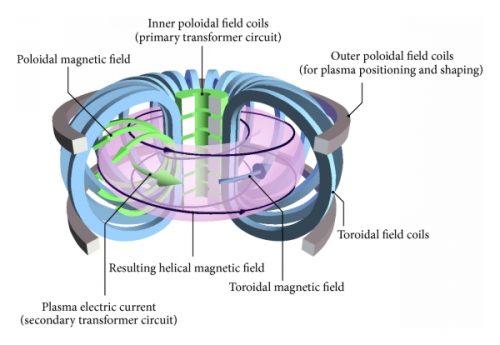
(Fig. 258) Cross sectional view of a Tokamak coil chamber
The heart of a tokamak is its doughnut-shaped vacuum chamber. Inside the chamber, gaseous isotopic hydrogen fuel is placed under extreme heat (between 150 and 300 million °C) and become ionized, turning into a plasma. These particles become “energized” enough to overcome their natural electromagnetic repulsion between positively charged nucleons and collide to fuse, releasing huge amounts of energy (Fig. 259).
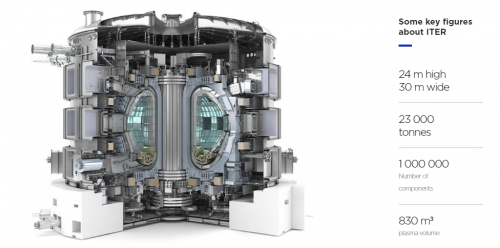
(Fig. 259) Specifications of the ITER Tokamak
Launched since 1985, the world’s largest tokamak reactor is the ITER, or the International Thermonuclear Experimental Reactor, which is being constructed in France, with most of it scheduled for completion for electricity generation in 2021 (Fig. 256). The machine is scheduled to be turned on in 2025 and is a joint program between the EU, India, China, Russia, Japan, the United States, and South Korea. Sustainability challenge is not yet fully positive.
Individual countries are trying to build their own fusion reactors. China launched the medium size tokamak fusion reactor HL-2M since 2009 (Fig. 260). The device is capable of generating plasma over 150 million degrees Celsius and the duration of triggered discharge is around 10 seconds, with an energy confinement time of a few hundred milliseconds. It was named as “Artificial Sun”.
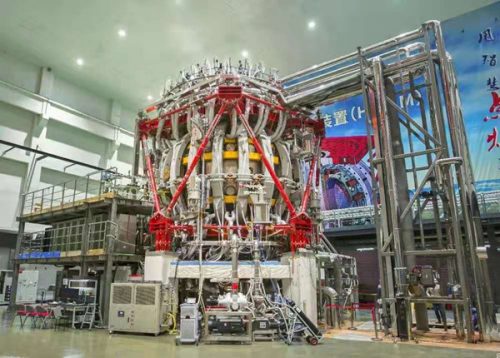
(Fig. 260) China’s HL-2M nuclear fusion reactor “Artificial Sun”
(ii) Present power stations employing nuclear fission technology
Controllable nuclear fission using uranium as fuel is widely used to provide an effective source of clean and sustainable energy as power station to generate electricity (Fig. 261). After years of usage, technology employed is mature and its efficiency is much higher than that of traditional power plants. It seems nuclear fission power plant is indeed a good choice for generating green energy. However, disposal of nuclear waste constitutes a very big problem because all radioactive elements have extra long half-life, some may hit millions of years. They have to be permanently sealed by radioactivity-screened inert materials and not allowed to be exposed. Although rigorous measures are taken to ensure safe operation of nuclear power plant, function of such power station is not 100% risk-free. Out of control accidents can result in extensive release of dangerous radiations, extreme case is just like radiations emitted from an atomic bomb explosion. Chernobyl Disaster of the last century was a well-known historical example.
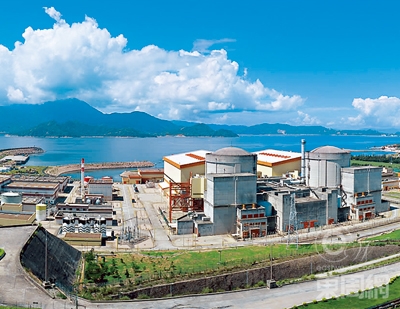
(Fig. 261) Daya Bay nuclear fission power plant
(iii) Cold nuclear fusion
The above two technologies of obtaining power from nuclear reactions are subjected to the unavoidable important problem of safety, let alone the input/output efficiency of reactors. An ideal situation could be to obtain massive amount of energy by undergoing safe nuclear fusion at room conditions (cold nuclear fusion). In the late 80s of last century, some scientists claimed that they achieved in obtaining “excess heat” by traditional electrolysis of heavy water and suspected that it was a phenomenon of cold fusion (internet search). However, attempts by a lot of scientists to replicate the experiment did not arrive at the expected result. It was finally regarded as “Pathological science”. The pursue for cold nuclear fusion actually raised inspiration of enthusiastic scientists, but up till now all proved no substantial developments.
Anticipate future achievements in all aspects of STEM could one day succeed in making cold nuclear fusion a reality, drastically solve the ultimate problem of energy source. Operation of safe and environmentally integrated cold nuclear fusion power plants may put an end to nuclear fission power plants and the not 100% risk-free hot fusion reactors.
c. Develop innovative and sustainable new materials
(i) Graphene (石墨烯) / new material composite of the century
The following descriptions of atomic orbitals, hybridization of atomic orbitals, overlapping of orbitals, σ bond, paired and unpaired electrons are not required for the DSE Syllabus. They are, however, very crucial in explaining the conductivity of graphene. The section can be regarded as an extension of study of graphite which is included in the Syllabus. Mentioned topics are readily available by browsing websites.
Graphite is one of the allotropes of element carbon. Graphite consists of layer of hexagonal carbon sheets. One 2s and two 2p Atomic orbitals of the carbon atom are 2s2p2 hybridized (special mathematical treatment, not chemical reaction), with 1 electron in each of the hybridized orbitals. The 3 hybridized orbitals overlap one another to form 3σ covalent bonds (paired electrons), each linking carbon atoms 2 dimensionally at 120o together as flat hexagonal carbon sheets. The carbon sheets are held together by weak van der Waal’s force (Fig 262). The unhybridized 2p electron (unpaired electron) of the carbon atom exists as free electron (Fig. 263) which accounts for the electrical and thermal conductivity of graphite.
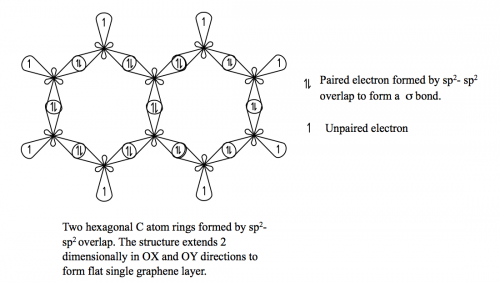
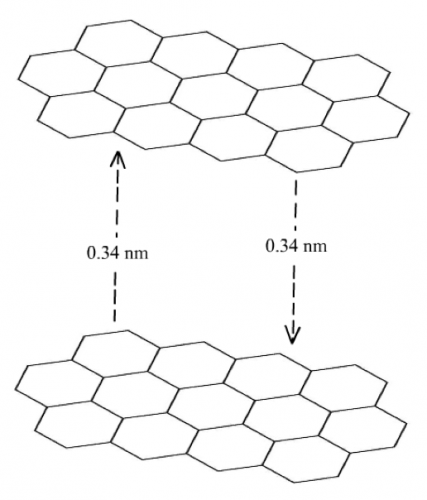 |  |
| (Fig. 262) Two graphene layers are held together by weak van der Waal’s force | (Fig. 263) Side view of two graphene layers |
Two professors, Andre Geim and Konstantin Novoselov, of Manchester University in 2004 succeeded in using a very simple method of peeling off a single layer from a graphite substrate using adhesive tape and identified its nature by Raman spectroscopy (Fig. 264). As a mono layer of graphene has very outstanding properties, worldwide extensive researches were conducted to find out the far-reaching applications of graphene. In 2010, the two professors were awarded the Physics Nobel Prize (internet search).
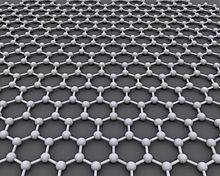
(Fig. 264) monolayer of graphene
The outstanding physical properties of graphene include: (i) extreme degree of hardness, (ii) high degree of viscosity, (iii) high ductility and flexibility, (iv) electrical and thermal conductivity much better than that of silver, (v) highly transparent, (vi) low density, (vii) possesses special electrical and optical properties and (viii) highly impermeable.
Graphene in various forms, e.g. nano-tubes, sheets, threads, coatings etc and in composite construction materials have limitless applications. Another advantage in using graphene is the raw material graphite is an allotrope of carbon which is completely renewable. Quite recently, many countries and multi-national enterprises had deployed a lot of resources in developing various applications of graphene, covering both the consumer or military sectors.
* Aspects of consumer applications (to quote just a number of major usages):
| (a) | Electronic information products It has been predicted that graphene can replace silicon as substrate of micro-circuit designs and develop much stronger chips. Touch-controlled screen made of graphene is superior than that of LED or OLED in being lighter, thinner, more sensitive and flexible, capable of being folded together (Fig. 265, 266).
| ||||
| (b) | A promising commercial material for high-temperature superconductivity As of today, only special synthetic material at near absolute K can perform superconductivity (zero electrical resistance), usually using liquid helium (- 269 oC) for operation. Lots of efforts had been attempted to increase the temperature requirement, but were short of finding a feasible way working at room temperature (298 K). In 2018, young Chinese Physics genius Cao Yuan (曹原) published a paper in the world renown scientific journal “Nature” announced a special phenomenon of superconductivity with two graphene layers inclined at a “magic angle of 1.1 degree” under a temperature of 1.7 K. Follow-up researches on graphene tri-layer revealed further properties. It is hoped that commercial use of graphene-based composite materials for superconductivity at 100 K high temperature (liquid nitrogen will do, no need to use liquid helium) will be available in the near future. | ||||
| (c) | Lithium battery made of graphene composite materials Performance of these batteries outweigh those of Ni-Cd or traditional lithium batteries (Fig. 267). Charging time, charging capacity, discharge capacity, storage capacity, life-time and recycling performance are superior than currently adopted commercial counterparts.
(Fig. 267) Schematic diagram of manufacture of graphene composite lithium battery | ||||
| (d) | An almost perfect composite material Graphene helps to design lighter, faster and safer automobiles and airplanes. The near-superconductivity property of graphene composite materials may be instrumental in designing new models of maglev trains (Fig. 268, 269). Graphene also occupies a place in innovative surface treatment technology, enhancing and activating properties of materials.
| ||||
| (e) | Medical equipment Development of bio-interfacing sensor technology is anticipated, especially carbon-based computational technique (Fig. 267). One aspect could be in improving the existing well-received MRI machines (Fig. 271). Extremely strong magnetic field is required for MR imaging, resulting from strong current passing through superconducting materials maintained at very low temperature (liquid helium, ~ – 270oC). MRI machines are expensive. However, MRI machines made of zero resistance graphene composite material maintained at high temperature (e.g 100 K instead of a few K) could be much cheaper and more affordable.
| ||||
| (f) | Quantum computers Graphene composite material can make commercial quantum computation hardware chips become a reality. Technology of present (0 1) state electronic logic gate computers has been advancing to 7 nm, 3 nm and even 2 nm EUV lithography. Surely, there is a bottom-line limitation of lithography in view of the fact that real time spent on switching from 0 state to 1 state and vice versa exists which cannot be annihilated, let alone the long-standing problem of excessive heat dissipation. (0 1) electronic logic gate computation is based on binary Boolean expression mathematics, using electromagnetic wave (artificial signals) as carrier and physically 0 state (0 V) or 1 state (5 V) for computation. Developing quantum computational technique has a number of possibilities and one of them is using photon, not electron, as carrier. Boolean logic cannot be used as quantum computation is based on the possibility of 0 state or 1 state and not a real time 0/1 state. Special electronic and optical properties of graphene is very promising in designing prototypes of quantum computers.
(Fig. 272) Graphene processors seem to dominate the future commercial quantum computer market | ||||
| (g) | Wetting property of graphene derivatives and as new auxetic material Graphene is naturally hydrophobic. Oxide of graphene (GO) is hydrophilic while reduced oxide of graphene (RGO) is hydrophobic. Graphene oxide-based DNA sensors could provide very inexpensive rapid DNA analysis. Smart textile fabrication using GO and RGO coatings is being developed to suit today’s commercial market. Graphene composite material can induce Negative Poisson’s Ratio (NPR). Materials with this special characteristic is said to be auxetic (Fig. 273). Layman’s meaning of auxetic materials can be expressed as “materials that become thicker on pulling”. Graphene as new nano auxetic material is expected to have novel applications, notably blast shielding materials.
(Fig. 273) Auxetic materials used for blast shielding purposes |
* Military applications
Due to strictly confidential nature, military usages of graphene are never disclosed. Internet search reveals possible military applications of graphene composite materials are due to properties of (i) extremely high electrical conductivity, (ii) ultra high hardness, (iii) high viscosity, (iv) high flexibility and (v) very low density. Still being developing electromagnetic catapult (電磁彈射器) of aircraft carriers and electromagnetic gun (電磁炮) should use graphene composite materials (Fig. 274).
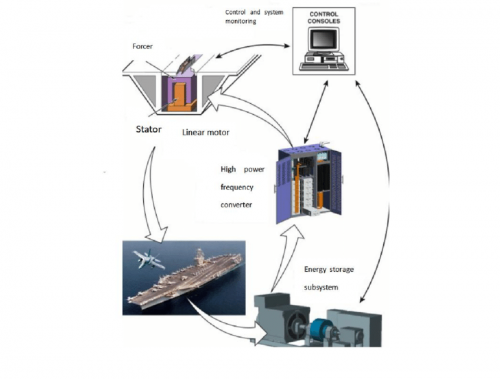
(Fig. 274) Simple schematic diagram of carrier’s electromagnetic catapult system, graphene composite materials are used in fabricating the linear accelerator
All in all, rediscovery of graphene has been the most important 21st century invention in novel material development.
(ii) Flurographite polymer CFn (氟化石墨)

(Fig. 275) 2D Flurographite polymer layer
Unlike the tetrahedral CF4 monomer, carbon atoms of -(CFx)-n polymer are sp3 hybridized and form puckered (皺摺) 2D layers (Fig. 275). All 4 electrons of the carbon atom participated in covalent bond formation, thus very weak intermolecular force exists between layers, making the layers liable to translational motion. It serves as an excellent lubricant.
Lithium batteries using fluorographite polymer as positive electrode(Li- CFn)provide high electrical energy storage capacity, wide operational temperature range and exceptional stable voltage output.
(iii) Quasicrystal (準晶體)
Classical crystallography defined crystals as lattices formed by extending unit cell 3 dimensionally to occupy the whole space. High school chemistry syllabus included the study of metallic crystal structure in terms of packing of atoms. Closed-packed layers are packed and stacked as abab… structure or abcabc…structure and the unit cell is deduced from identifying the packing crystal (DSE Syllabus Topic XIV Material Chemistry). University level approach uses Miller index in lecturing crystal structures. Irrespective of teaching levels, crystal lattices are considered, in all possible cases, as separate particles arranged in certain ordered and periodic patterns. This was the “golden rule” of classical crystallography study.
In 1984, Dan Shechtman and his team of Israel Institute of Technology discovered a new material from rapid cooling of an aluminium-manganese alloy. Its electron diffraction pattern was substantially different from an expected traditional ordered and periodic pattern. In 1997, a meteorite with a composition of Al63Cu24Fe13 (icosahedrite) was found naturally in Khatyrka (eastern Russia) with an electron diffraction pattern that agreed with the characteristics of a synthesized quasicrystal (Fig. 276).
Quasicrystals: Prof. D. Shechtman
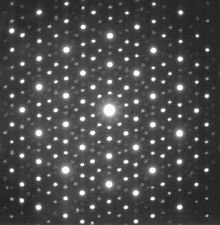
(Fig. 276) Characteristic five-fold electron diffraction pattern of an icosahedral lattice
Dan Shechtman was awarded the Chemistry Nobel Prize in 2011. In a nutshell, a quasicrystal is “A Metallic Phase with Long-Range Orientational Order and No Translational Symmetry”. This lattice pattern (Fig. 276), somewhere between one of an ordered sequence and one that is pattern-less, or a quasicrystal, was recognized to be not existing naturally, except by laboratory synthesis. The discover of the new natural mineral Al63Cu24Fe13, which exhibits the illegitimate 5-fold symmetry (internet search: rotational symmetry), characteristics of a quasi-lattice, undermined the deep belief of an ordered pattern as the basic conception of a crystal.
The ordered part of a quasi-lattice is arrangement according to the “Fibonacci Sequence” (internet search: Fibonacci series, ratio of two successive Fibonacci numbers, golden ratio 1.618033…and solution to the quadratic equation x2 – x – 1 = 0) which starts from 0 and 1, then the numbers behind are equal to the sum of the previous two. The first part of the series is: 0, 1, 1, 2, 3, 5, 8, 13, 21, 34, 55, 89, 144… Fibonacci numbers and golden ratio are frequently found in human structures, flowering plants, architectural buildings etc (Fig. 277, 278, 279, 280). In the stock market, analysts use the golden ratio of 38.2% to examine major price movement trends for the market as a whole or for a particular stock.
 |  |  | 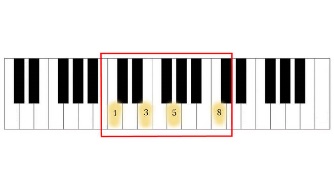 |
| (Fig. 277) Fibonacci spiral in sunflower | (Fig. 278) A lady’s face as per golden ratio | (Fig. 279) A Fibonacci spiral staircase | (Fig. 280) An octave of 13 notes of a piano is in the Fibonacci sequence of 2,3,5,8 and 13 |
Quasicrystals have special attributes. They are extremely hard yet elastic and exceptionally smooth. Unlike metals, their conductivity of electricity and heat are poor. Researchers are trying to find applications of quasicrystals and their composites in the consumer or domestic sectors, like novel LED, non-sticking materials etc. Also, it is anticipated that quasicrystal composites should play a role in the high temperature-resistant infrastructure of space vehicles.
(iv) Stealth material (隱身物料)
For a long period of time, lenses of cameras and corrective glasses were coated with a layer of transparent adhesive so that reflected ray from the surface of the lens or glass would be mostly eliminated and allows the refracted go unobstructed to the sensor (or the film in earlier days) or the eye. The theory behind it is not too completed (revise Program (1), Topic 11 page 165) but the involved technology is quite advanced. The applied transparent layer has a thickness of 1/4 wavelength of the incident ray. The reflected ray from the front coating surface and that from the back of the coating (uncoated lens surface) will superimpose (mathematical vocabulary means wave function added together), undergoes destructive interference, resulting in total annihilation of the two rays. Reflected rays are thus eliminated by a layer of coating (Fig. 281). This layer is called “quarter wavelength coating”.
We see things because objects reflect incident ray and our eyes receive the reflected ray, optical nerves of the eye ball instruct the brain to tell the nature (due to reflected wavelength), brightness (due to reflected amplitude) and size (due to phase difference of reflected ray) of the object (revise Program (1), Topic 6, page 32). If objects are covered with a special coating such that no rays are allowed to be reflected, then we cannot see the object and we say it is invisible. However, one vital factor of such technology is to consider the range of wavelength of reflected ray. For example, a person wearing this kind of clothing may be invisible in daylight, but will become visible if the person is irradiated with red, green or blue monochromatic light.
Such stealth technology was widely used in military weapons to make them “invisible” to microwave radars. Stealth fighter jets like the US F-22, F-35 or China’s J-20, J-31 or warships are built with special shapes and microwave-absorbing coatings to make them appearing as only tiny spots on the reception radar. As pointed out earlier, if meter wavelength radar is used to scout these airplanes, they would no longer be “invisible” anymore.
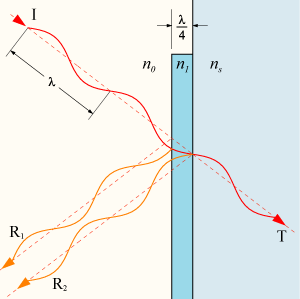
(Fig. 281) Destructive interference of waves results in annihilation
Consumer use of such coating material may incur moral arguments or judicial proceedings. If confined by suitable monitoring mechanisms, applications of stealth materials can be considered as STEM achievements.
(v) Innovative materials produced by tailor-make 3D printing devices
Traditional two-dimensional computer printing involves ink, paper and supporting hardware and software. As its name implies, printing product of as 3D printer is a 3-dimensional object (Fig. 282). Like traditional printing, special hardware and software are required and the “ink” of a 3D printer can be plastics, liquids or powder grains. Instead of delivering a document or photo, an object is printed instead.
Conventional printer prints by line scanning while a 3D printer prints by layer scanning and the printed object is built by depositing layer after layer (Fig. 283). Professional use of 3D printing is the prevailing trend of further development of this technology.
 |  |
| (Fig. 282) A commercial 3D printer | (Fig. 283) 3D printing by scanning layers |
Areas mostly adopted present and future 3D printing technologies include:
| * | Military use Fighter jet engine component parts, missiles, small submarine hulls, customized drones, handguns and much more (Fig. 284, 285).
| ||||
| * | Industrial Sector Prototypes and light-weight components in aerospace, light-weight internal combustion engine block, aircraft internal components, automobile custom seats, spare and replacement parts and much more (Fig. 286, 287).
| ||||
| * | Medical field Recent innovations in the medical field associated with 3D printing include the following four core uses: creating tissues and organoids, surgical tools, patient-specific surgical models and custom-made prosthetic(義肢) (Fig. 288, 289). Much human and financial resources are allocated to this field of professionalism, world-wide.
| ||||
| * | Architectural field Except the foundational structure or the structural foci of high-rise buildings, a lot of parts of a building can be 3D printed. Benefits of 3D printing for construction include: fast production, almost zero material waste, cost-effective, capable of innovative designs etc. In most cases a robotic arm extruder is involved. Concrete and metals can be moulded and 3D printed layer by layer into various shapes. 3D printing paves way for a new lifestyle (Fig. 290, 291).
| ||||
| * | Consumer market Small size 3D printers play an important role in the consumer market, notably in the educational sector. Single chip computer coupled with 3D printer is widely used in the promotion of STEM education at school and university levels. Recently, the “veg” style of eating stimulates 3D printed veg meat production in the food industry (Fig. 292, 293).
|
Legal aspects
Rapid development in the area of 3D printing raised the possible problem of offending current laws and regulations. The emphasis lies on the issues that arise from intellectual property law (IP), and more specifically copyright law, patent law, design rights law, and trademark law. In addition to these IP issues, the doctrine of product liability as it relates to 3D printing could be an area of liberal studies.
(vi) Innovative packaging material that can substitute the widely used devastating non-degradable plastics
| * | Manufacture and extensive use of non-degradable plastics Extensive use of plastic containers causing severe ecological environment destruction had become the most imminent problem human beings have to solve. At present, the prevailing strategy is by using the “4R” method: Recycle, Reduce, Reuse and Replace. Promotion of using degradable plastics, biodegradable plastics and compostable plastics have also been encouraged. After years of practice, the latter three non-traditional methods did not seem to meet expected outcomes. The deep and complex reasons behind the results are beyond the scope of our present discussion. Perhaps we should concentrate our attention on the production of non degradable plastics rather than on its use and disposal. The less we produce plastics, the better eco-environmental situation may become. However, one point to be noted: all plastics are manufactured from the derivatives of fractionation of crude oil. Limiting the production of plastics would also mean tipping the balance of the major fractionation products of crude oil such as car petrol, airplane kerosene, heavy oil for ships and heating etc. This could mean a change in the mode of consumption market of crude oil. However, the scale of consumption of crude oil fractionation derivatives for plastic production is relatively small, Limitation of production may mean higher prices for plastics which is a positive signal for environmental protection. Unless implementation of renewable energy has enough coverage and hence alleviate the scale of consumption of fossil fuel, we do not have room for appreciable reduction of production of crude oil and hence raw materials for plastics. Following the technique of using Ziegler-Natta catalyst in polymerizing linear terminal alkenes (Karl Ziegler was awarded the 1963 Nobel Prize in Chemistry, Fig. 294), as of 2010, the total volume of plastics, elastomers, and rubbers produced from alkenes with these and related catalysts worldwide exceeds 100 million tons. These polymers represent the largest-volume commodity non-degradable plastics in the world
(Fig. 294) Mechanism of Zr-catalyzed ethylene polymerization. When one goes out for shopping today and at the end of the day, what is the chance of getting no plastic carrying bags or no gifts/presents made of plastics of partly made of plastics? The effect of implementing the “4R” method, i.e recycle (回收), reduce (減少), reuse (再用) and replace (代替) is not satisfactory. Annual ecological environment destruction caused by non-degradable plastics increases rather then decreases. One appreciable scale of disposing these kind of plastics is by incineration (焚化) or combustion. Majority of polymerized plastics consists of chains of -CH2- bonds. High temperature can cater for the rupture of the strong -C-C- or -C-H- covalent bonds. Incineration of plastics releases heat which can be converted into electrical energy. However, incineration generates a lot of pollutants which deteriorate the environment. The pros and cons of adopting incineration is often a social issue of constant debate. | ||||||||||||||||||||||
| * | Innovative room temperature solid metastable water polymer as packaging material Molecular structure of water DSE Topic VI (Microscopic World II) mentioned the molecular structure of water molecule and hydrogen bonding at the Valence Shell Electron Pair Repulsion (VSEPR) theory level. Using the Valence Bond Hybridization of Atomic Orbital approach (refer to page 202) can give a clearer three-dimensional bonding perspective.
The oxygen atom of the water molecule is assumed to be 2s2p3 hybridized. Each of the two hybrid orbitals receive one unpaired electron while each of the other two hybrid orbitals have one lone electron pair. The 3D geometry of a sp3 hybrid is a simple cubic with hybrid orbitals directed at the opposite corners of the top and bottom faces (Fig. 296). Diagrammatic representation of a water molecule is usually simplified as shown in Fig. 295. All electrons of the water molecule are paired (2 lone pair + 2 O-H σ bond electron pairs) and there are no free electrons. Hence pure water molecule is an electrical insulator. The mysterious hydrogen bonding Hydrogen bonding exists around us, everywhere, even our bodies. A hydrogen bond is primarily an electrostatic force of attraction between a hydrogen atom, itself is covalently bonded, and a more electronegative atom bearing a lone pair of electrons. It can be looked upon as a partial covalent bond with a weak bond energy, in the order of ten kJ mol-1 (e.g. O-H…O, 21 kJ mol-1). Some also looked upon it as a kind of special 3 electron bond. As of today, scientists still cannot find a satisfactory theoretical quantified model for such kind of bonding. Association of water molecules through hydrogen bonding Traditionally, hydrogen bonding was grouped under the category of intermolecular force, However, because of its unique nature, scope of coverage and its strongest strength among the group, Hydrogen bonding was singled out as a kind of special bonding for research studies. Relative strength of bonding:
(Fig. 297) Relative strength of bonding Water molecules can associate through hydrogen bonding to form sections of chains or other shapes (Fig. 298, 299). Strength of hydrogen bonding enables such association to undergo 3-dimensional extension, like ionic bonding. Normally, associated aggregates involve 6-7 water molecules. They form and break constantly, resulting in liquid state.
| ||||||||||||||||||||||
| |||||||||||||||||||||||
d. Is electrical power the ultimate source of power?
As early as 18th century, people knew electricity could generate force to do work. Up till now, every activity of our society must have some linkage with electrical power. Using a not too nice phrase: “we have been slaves to electricity for more than 100 years”. Can there be another source of energy to completely replace electrical power?
Humans had been successively harnessed electron for hundreds of years for its seemly endless use in all kinds minute and huge equipment covering nano micro-scale appliances to space station. Albeit its acquaintance with us, its particle-like (9.11 x 10-31 Kg, -1.6 x 10-19C, spin 1/2) presence had not been detected physically not until recently scientists used short pulses from intense laser light, called attosecond (10-18 s) pulses, have managed to capture the electron motion for the first time (Fig. 301).

(Fig. 301) Electron momentum distribution as a function of time delay recorded by velocity map imaging spectrometer (VMIS) using intense attosecond laser pulse at Lund University in Sweden.
When electricity passes through a conductor, it is essentially classified under two categories: (i) Direct Current, DC (after Edison) and (ii) Alternating Current, AC (after Tesla). Both DC and AC electric currents are widely used in all areas affecting our daily lives.
| * | Macroscopic applications of electricity Mountains of applications based on the principle of Lorenz force (electromagnetic force) are found in motor driven appliances like electric motor, washing machine, air-conditioner, refrigerator, lift and escalator, petrol vehicle (Fig. 302), alternative fuel vehicle (新能源車), electric car, tram etc. Illumination by electric power (Fig. 303) is also very important. The present domain of innovations like aerospace (Fig. 304, 310), advanced military communication and weapons (Fig. 305, 306), controllable hot nuclear fusion (Fig 307), new materials, IT etc are all using electricity as their starting platform. All in all, when one leaves from his or her living place to attend outdoor activities, he or she will always find electricity at work or things refined by electricity. Electric power is with us anytime, anywhere, both seen or unseen.
| ||||||||||||
| * | Microscopic applications of electricity – The digital world Electronic applications of binary Boolean logic expressions used in chip manufacture had revolutionized the ecosystem of microelectronics. As time passed, we experienced a drastic change of communication pattern from cable to wireless transmission upgrading from analog 1G to digital 2G, 3G, 4G and 5G (Fig. 309). The central piece of component in all digital devices is an electronic logic gate chip. At present, the most controversial issue in the smartphone market is the availability of SoC chips. Scrambling for hundred million of orders for SoC chips involving 7 nm or less EUV lithographic technology had resulted in severe shortage of supply. The bottle-neck of the manufacturing flow of SoC chip is the highly advanced EUV lithographic machine manufactured by ASML holdings (Fig. 308). Unfortunately, this machine needs electricity to operate.
| ||||||||||||
| * | Life without electricity Metals above iron in the electrochemical series can only be extracted from their ores by electricity. The “Iron Age” was roughly defined to cover a span of 300 -3000 years before. In the 18th century, the toughest metal people can use is iron because electricity had not been discovered and metals like aluminium, zinc or sodium could not be extracted from their ores. Without electricity, people of nowadays would suddenly face problems of livelihood same as that of the 18th century. Travelling by walking was assumed and riding on a horse was a luxury. Fire heating by burning wood and not electric cooker. Fetching water from a well instead of turning on a water tap. Candles instead of LED lightings. The only large-scale industrial plant could be blast furnace to produce iron (Fig. 311, 312). All these were real and not fictitious. Are you happy with a such living style? I would have thought environmental activists would welcome such ecosystem and that is the exact way to save the Earth so that it can stay healthy for the coming centuries.
| ||||||||||||
| * | “Age of Electrical Power” could be the ultimate post “Iron Age” We are living in the post “Iron Age” in which electricity is the dominating source of consumer power of energy. All man-made things on Earth have at least one connection with the use of electricity. Apparently, we cannot conserve our living style without electricity and that will remain the same or even more dependent for centuries to come. Even when commercial use of nuclear fusion is expected to be available in the near future, the output to all end-users will still be electricity. Electricity is like an invisible mighty dome that capture all human activities. |
e. “Dark Matter” (「暗物質」) and the hope of using it in future
For more than decades, scientists had been eyeing on extra-terrestrial space for possible source of unknown and powerful energy.
Our entire universe consists of 5% ordinary matter (visible mass in terms of atoms), 27% “dark matter” (Fig. 313) and 68% of “dark energy”. The latter two constitute 95% of total mass–energy content. In the everlasting pursue for energy source, human beings are able to practically relate advanced mathematical concept (fundamental strong interactions) and experimental design (reactor) and achieve nuclear fusion for gigantic scale of electricity generation. This is feasible for a 4 dimensional world in which ordinary matter prevails. Can human harness the “dark matter” which seem to exist beyond 4 dimensional outer space as we did with energy conversion on Earth?

(Fig. 313) Hubble Space Telescope composite image shows a ghostly “ring” of dark matter in the galaxy cluster Cl 0024+17.
In order to scientifically explain phenomena and explore their applications, the traditional way is to undergo the (theory followed by experiment) procedure. If we adopt the same approach to unveil the nature of “dark matter”, it seems we also have to do it in the same way. The Standard Model involving Fermions (matter) and Bosons (interaction) or the quantum-quark theory approach works for ordinary matter on Earth and can be experimentally demonstrated, notably the controllable hot nuclear fusion reactor in which strong interaction between nucleons of the H atoms is overcome by extremely high temperature plasma. However, the Standard Model did not involve gravitational interaction which is a crucial factor for extra-terrestrial studies. Scientists turned to other theory which can describe mathematically the behaviour of outer space.
After years of intense discussions, the String Theory seemed to be the most promising mathematical model for matter-gravitation description. As of today, such model remained at the mathematical stage and no experiments had ever been attempted. The key point being able to capture “dark matter” and perform experiment on it. Doing it in the CERN (European Organization for Nuclear Research, French pronunciation) collider or performing the XENON experiment are actually working with ordinary matters, not “dark matter”. Whether we human beings can harness “dark matter” (e.g by experimentation) or not cannot be answered for generations to come.
Where Did Dark Matter and Dark Energy Come From?
String Theory



